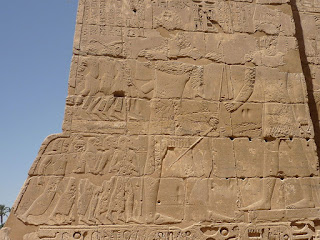 |
| Tiglath-Pileser III |
"…The people ate one another's flesh to save their lives. Like a flood's ravaging water the Aramean rulers became strong, plundered the crops of Assyria, conquered and took many fortified cities of Assyria."
Inscription by Tigleth-Pileser I describing the attacks of the Arameans.
When Assyria next has a strong military commander (Tiglath-Pileser I in the year 1114BC) the Babylonian threat has passed but a new people, the Arameans, inhabit Syria. Tiglath-Pileser reported that he devastated them in retaliation for their attacks on Assyria but the Arameans were to be a threat for several hundred years and it was not until around 732BC during the reign of Tiglath-Pileser III that the Arameans were finally crushed by Assyria.
After the chaos surrounding the end of the Bronze Age, the old empires had either fallen, gone into terminal decline or been locked in perpetual conflict. This allowed the areas at the edges of civilisation to gain their independence and for new ideas, cultures and peoples to thrive. While the stability of the Bronze Age was sometimes viewed as golden the new cultures of the Iron Age would go on to irrevocably shape the world as we know it. In the temporary absence of the great empires political entities such as the Greek city states or the Israelite kingdoms were able to flourish and create cultural legacies that last to this day.
 |
| Temple at Delphi: a centre of later Greek civilisation |
"Great was their strength and unconquerable the arms which grew from their shoulders on their strong limbs. Their armour was of bronze, and their houses of bronze, and of bronze were their implements: there was no black iron. These were destroyed by their own hands and passed to the dank house of chill Hades, and left no name: terrible though they were, black Death seized them, and they left the bright light of the sun.
But when earth had covered this generation also, Zeus, the son of Cronos, made yet another, the fourth, upon the fruitful earth, which was nobler and more righteous, a god-like race of heroes who are called demi-gods, the race before our own, throughout the boundless earth. Grim war and dread battle destroyed a part of them, some in the land of Cadmus at seven-gated Thebes when they fought for the flocks of Oedipus, and some, when it had brought them in ships over the great sea gulf to Troy for rich-haired Helen's sake: there death's end enshrouded a part of them. But to the others father Zeus, the son of Cronos, gave a living and an abode apart from men, and made them dwell at the ends of earth. And they live untouched by sorrow in the islands of the blessed along the shore of deep swirling ocean, happy heroes for whom the grain-giving earth bears honey-sweet fruit flourishing thrice a year, far from the deathless gods, and Cronos rules over them for the father of men and gods released him from his bonds. And these last equally have honour and glory.
And again far-seeing Zeus made yet another generation, the fifth, of men who are upon the bounteous earth. Thereafter, would that I were not among the men of the fifth generation, but either had died before or been born afterwards. For now truly is a race of iron, and men never rest from labour and sorrow by day, and from perishing by night; and the gods shall lay sore trouble upon them."
Hesiod, Works and Days
 |
| Relief of Sea Peoples at Medinet Habu |
1208BC: Simultaneous attack on Egypt by Nubians and Libyans with Sea Peoples allies
1207BC: Assassination of Assyrian king Tukulti-Ninurta I
c.1200BC: Destruction of Mycenaean citadels at Tiryns, Mycenae and Pylos
c.1200BC: Destruction of Hittite capital of Hattusa
c.1200BC: Destruction of citadel at Troy
c.1192BC: Destruction of Ugarit
c.1178BC: Battle of the Delta: Ramesses III defeats Sea Peoples invasion of Egypt
c.1158BC: Sack of Babylon by Elamite king Shutruk-Nakhunte and end of Kassite Dynasty
Related Blog Posts:
Collapse of the Bronze Age: Part I
Collapse of the Bronze Age: Part II
Collapse of the Bronze Age: Part III
The Late Bronze Age in the Middle East
The Early Iron Age and the Death of Kings: I
great read, wish I was more aware of the history when I visited some of the sites.
ReplyDeleteYou should do a live travel route/history blog of some kind :)
Some quite spectacular sites in those regions for sure. A travel blog would be an excellent idea at some stage in the future!
ReplyDelete